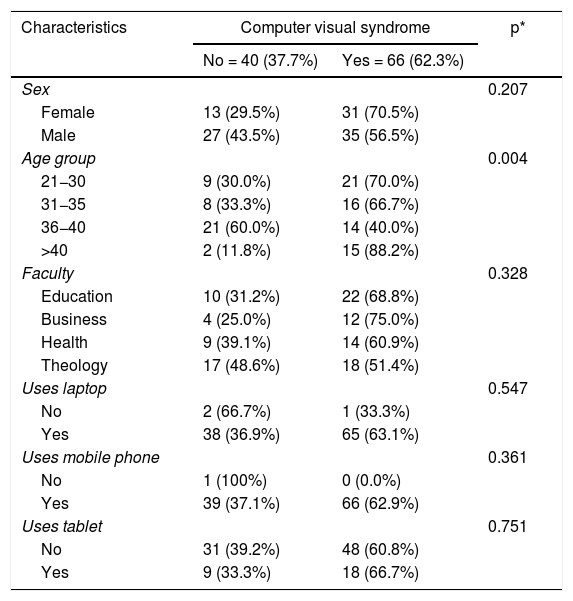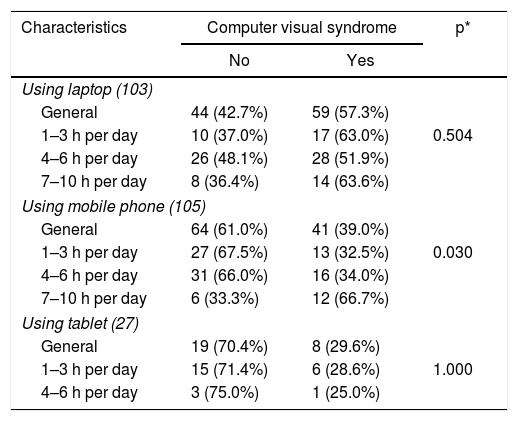In recent decades, several studies have found a strong association between prolonged use of video display terminals and ophthalmological symptoms encompassed in the so-called computer visual syndrome (CVS). Few studies have addressed this syndrome in graduate students.
MethodsObservational, cross-sectional descriptive study. A total of 106 postgraduate students were surveyed without ophthalmological pathologies. The diagnosis of CVS was made by means of the questionnaire of Seguí et al. validated in Spanish, which evaluates the frequency and intensity of 16 ocular symptoms.
ResultsThe prevalence of CVS among graduate university students was 62.3% (95% CI: 52.3–71.5). It was found that the highest proportion of students with the syndrome was in the group of older than 40 years old (88.2%) and in the group 21–30 years old (70.0%), showing statistically significant differences (p = 0.004). According to the device and its time of use, students who used the mobile phone for 7–10 h a day showed a higher prevalence of CVS compared to those who used the device for less time (p = 0.030). The business School had the highest prevalence (75.0%).
ConclusionThree out of every five graduate students presented CVS with this prevalence being like reported in other populations. There is a need to investigate possible interventions that can help reduce this entity.
En las últimas décadas diversos estudios han encontrado una fuerte asociación entre el uso prolongado de los videoterminales y síntomas oftalmológicos englobados en el denominado síndrome visual informático (SVI). Pocos estudios han abordado este síndrome en estudiantes de posgrado.
MétodosEstudio observacional, descriptivo de corte transversal. Se encuestó a 106 estudiantes universitarios de posgrado sin patologías oftalmológicas. El diagnóstico de SVI se realizó mediante el cuestionario de Seguí et al. validado en castellano, el cual evalúa la frecuencia e intensidad de 16 síntomas oculares.
ResultadosLa prevalencia de SVI de los estudiantes universitarios de posgrado fue del 62,3% (IC 95%: 52,3–71,5). Se encontró que la mayor proporción de estudiantes con el síndrome estuvo en el grupo mayor de 40 años (88,2%) y en el grupo de 21–30 años (70,0%), mostrando diferencias estadísticamente significativas (p = 0,004). Según el dispositivo y su tiempo de uso se observó que los estudiantes que utilizaban el teléfono móvil de 7 a 10 h diarias presentaron una prevalencia de SVI mayor en comparación con quienes utilizaban el dispositivo menos tiempo (p = 0,030). La Facultad de Ciencias Empresariales presentó la prevalencia más elevada (75,0%).
ConclusiónTres de cada cinco estudiantes universitarios de posgrado presentaron SVI, siendo esta prevalencia similar a lo reportado en otras poblaciones. Es necesario que se investiguen posibles intervenciones que puedan ayudar a reducir esta entidad.
Artículo
Comprando el artículo el PDF del mismo podrá ser descargado
Precio 19,34 €
Comprar ahora








